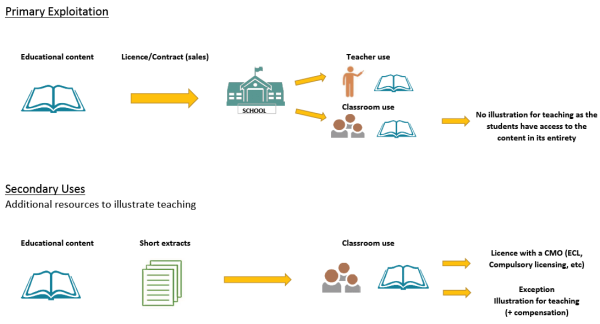For the 2024-2029 mandate, European publishers call on the European Parliament to uphold a vibrant publishing sector, the largest cultural industry in Europe, ensuring that we can continue to freely publish a wide variety of books, guaranteeing freedom of expression, a plurality of opinions and our democratic values.
Search
Members Login
Contact us
European copyright solution must support all
Teachers and students travel in Europe. This is great. And it is important that when they access their educational material (whether the primary use or the secondary uses, see below), either in the country where they are teaching or enrolled or in any other country of the EU, they have legal certainty. The legal fiction in the EC proposal (access is deemed to take place in the country where the students are enrolled) achieves this purpose while maintaining the national legal traditions (from the Nordic ECL to the German educational licence to name just two).
In 2001, the legislators chose to adopt an illustration for teaching exception. This covers all types of learning provided that there is an illustration by the teacher of her/his course. A teacher must be able to use, under licences or an exception, material to teach, we cannot agree more. However, we fail to see why informal education would require illustration for teaching, hence we don’t see the rationale to include informal education in the scope of the Article 4.
Primary use
Today, rightholders offer books, or modules, or digital learning material (DLM) at various level of granularity and different business models.
A book, a module or digital learning material is bought/licensed either by a single user – the teacher or the student, or for classroom uses - the teacher + the pupils. The teacher will buy (or more often receive from the publisher) a copy for her/himself and will possibly recommend the title to the entire class (models of acquisition will depend on the country: sometime it is the parents, sometime the educational institution/collectivity, who will pay for the book/digital learning material). In case of digital learning material, the licence will cover an individual use or a classroom use and have cross-border scope (students will be able to access the DLM in the classroom, at home or anywhere from their computer, through a secured network). We are not talking of illustration for teaching in these circumstances. However, these individual licenses may also allow secondary uses, in particular in higher education and research.
Secondary Uses in the context of illustration for teaching
A teacher wants to use part of a book or DLM to exemplify a topic (illustration for teaching) in her/his physical or virtual classroom. In certain cases educational establishment can find a licence available from the rightholders. If not, the law will allow that use either 1. through licences with a Collective Management Organisation (CMO) (these can be Extended Collective Licences - ECL, Compulsory licences, voluntary licences); or 2. through exceptions to copyright (possibly compensated for). Whatever the system is, the teacher/school must have legally acquired the book/digital learning material beforehand.
Therefore, to affirm that licences are preventing reuses is incorrect as in the first case (primary use), books, modules and DLM are used normally in the classe and not just as an illustration for teaching and in the second case, there are systems in place either through exceptions or through licences to allow teachers to use short extracts of works to illustrate their teaching. Both systems foresee uses on the premises of an educational establishment or through a secure electronic network accessible only by the educational establishment’s pupils or students and teaching staff.
Licences are the preferred option for authors and publishers because they are more flexible, easy to adapt to the change of digital environment and to new uses, new educational processes, and new business models. Any limitation of the licensing will inhibit innovation in the educational content creation and publishing.


